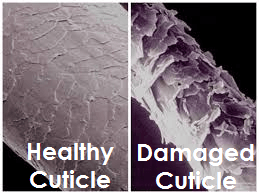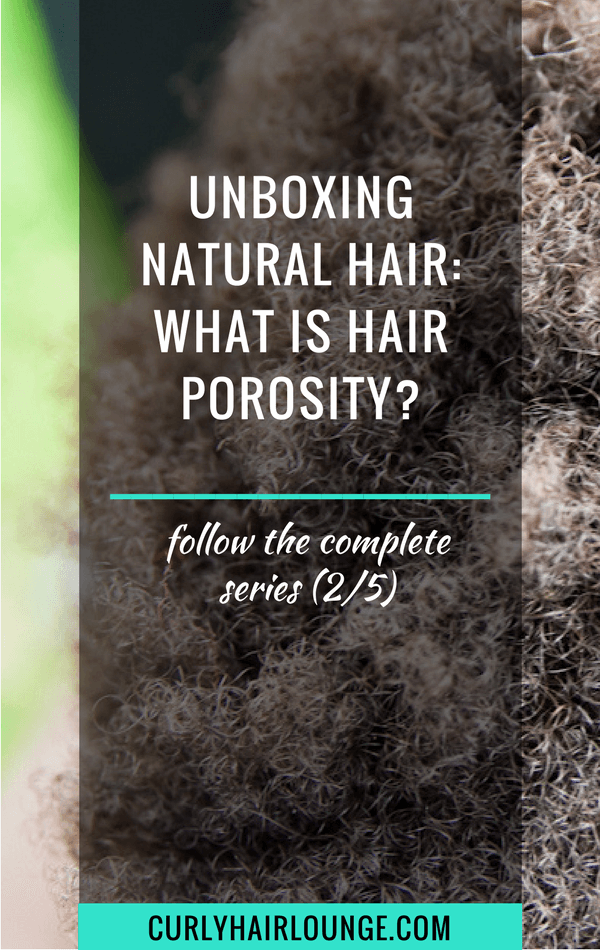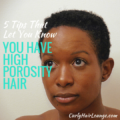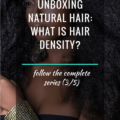Hi there! I hope you’re ready to continue our series of Unboxing Natural Hair! Today we will talk about what is hair porosity. We now know that according to Andre Walker there are 4 different hair types and each one has its own characteristics. This is important because it helps us understand how our hair responds to styling and products.
However, this alone is not sufficient to understand how natural hair behaves. So let us dive into hair porosity straight away.
What is Hair Porosity?
Hair porosity is the ability of hair to absorb and retain moisture into the hair shaft. This is determined by the flexibility of the hair’s cuticle (outer layer) to open and it varies between low, medium and high porosity.
Like many things in our bodies hair porosity is genetic, but this can also be influenced by the damage done to the cuticle layer. Exposure to sun, sea, chlorine (swimming pools), heat, dyeing and/or relaxers can affect how porous hair is.

If this concept seems a little hard to understand when it comes to your hair, ask yourself “Does my hair get easily/quickly soaked in water when I step under the shower?”, “When I wash my hair how long does it take to dry, before applying any products?”. I believe my hair has medium to low porosity as it retains moisture very easily for a long time.
How do I Know My Hair Porosity?
To know your hair’s porosity, the quickest and easiest way is to do the hair strand test. In this test, you will get a single strand of clean washed hair, free of any products, and place it in a glass of water. Observe the hair for a couple of minutes (2-4) and if it floats it has low porosity if sinks it has high porosity.
High, Medium and Low Porosity
High Porosity – Hair with high porosity has its cuticle layers open, it absorbs moisture very easily. Nevertheless, it doesn’t retain it and lets it slip just as easily. Highly porous hair has holes in its structure which can be the result of genetics or damage to the hair’s outer layer. The latter can be easily damaged. This type of hair will lack shine, will be prone to frizz and will have difficulties accepting chemical treatments such as dyeing.
Medium Porosity – This hair is what we all desire. The cuticle layers of the hair are compact but open just enough to absorb and retain moisture properly. Medium porosity hair looks healthy, has elasticity and takes in chemical procedures well. This hair is easy to style and maintain.
Low Porosity – In essence, low porosity hair “repels” moisture because its cuticle layers are so compact they resist the penetration of moisture in the hair. This hair is prone to build up since products just seem to rest on the hair. However, it is considered a healthy hair, because when moisture does get in it is adequately retained by the hair. One important issue to consider in low porosity hair is the fact that it resists chemical treatments.
Why is This Important to Know?
It is important to know hair’s porosity because its ability to retain moisture will determine the health of your hair and will influence elasticity and texture. I hope you have realised by now that without proper moisture hair becomes dry, dull, brittle which will lead to breakage and inability to retain growth. And this is more so for curly, wavy and kinky/coily hair.
How is This Connected to Andre Walker’s Hair Types?
Well, you know from my previous post that among other characteristics, hair type is determined by curl pattern/shape and this is highly affected by moisture. Without suitable moisture, you will have difficulties “showcasing” your curls.
If your hair has low porosity you will need to find products that are suitable for your hair. Nevertheless, keep in mind that hair porosity can change. As mentioned before, hair can be damaged by chemical treatments, sun or heat and this will affect porosity. Therefore, it is important to know your hair type but is also important to know your hair porosity.
This ends our porosity lesson. I hope you now have a clearer understanding of how important it is to know your hair type and porosity and how they are connected. Next, we will talk about density.
Have done your strand test? What is your porosity?








16 thoughts on “Unboxing Natural Hair – What Is Hair Porosity?”
This is very informative. For a topic that I know very little about, this helps. One suggestion that I might give you is to use a different color than Teal. It is a little difficult to see. Other than that…good job.
Hi Curt! I’m happy you find it informative. For a guy, this type of info is not very appealing, but if you want good hair this is important. I’m surprised you find teal a difficult colour. I love it! Anyway, thanks for your feedback on that, will have to consider it.
I love your blog, it so informed, clean looking and I learn so much everytime I stop by. Never heard the word porosity before. Learn something new every day.
Anyways, thanks for all the info.
Hi Debra. I always try to provide information in a clear and simple way and I’m happy you learned something new today. 🙂
What would you recommend to someone with changing hair porosity? I’m pregnant right now and have the driest hair I’ve ever had, and I don’t usually have a problem with that. Any suggestions would be great.
Hi Sarah, hair porosity is determined by your genes and can cahnge due to chemical and/or environmental factors. Pregnancy shouldn’t have nothing to do with it. Have you considered your shampoo? Have you done any chemical treatment prior to pregnancy or early on? You can read this post to find out how to improve your hair porosity. Do a hair strand test too find out if you really have it.
Beautiful site. This post was very informative. As a newbie natural, I find that there are so many things that I had not considered prior to the big chop. The porosity of my hair being one. Thanks for taking the time to inform and educate on this topic.
Hi Roni, your welcome. I’m glad I could be of help.
I have heard of hair porosity, but never got to know details. You have explained in detail on how to know. The water density test is an awesome tip! Thanks for sharing.
Thanks Demi, I’m always trying to help.
How would I know what time of hair porosity I have. Have been doing relaxers since I was a kid, and tried being natural for almost 2 years but reverted back to relaxer again. I have dry and strong hair and no moisture seems to enter, only stays on the other hair.
Hi Frances,
To know your porosity you can make a simple hair strand test in a glass of water as it is explained in this post. Having relaxed hair you should lean towards high porosity which is when water gets in easily but doesn’t stay in, so your hair will be dry. Do a hair strand test, but remember to use a hair strand that has been cleaned with a clarifying or regular shampoo.
Beautiful site. Very informative. My hair absorbs water quickly and gets dried quickly also. I did the strand test and my hair was floating for more than 2 hours but I gave it a little push and it immediately sank to the bottom of the glass. How would you classify my hair porosity?
Thank you for your feedback on the blog. To make sure you find out what your porosity test is, first make sure your hair is clarified and then do the test. Two different measures you can use in conjunction are checking under the shower to see how long your hair takes to get fully wet and also to make note of how long your hair takes to get dry once it’s well moisturised. My hair takes ages to do both and it’s low porosity. Do all three and confirm your hair porosity.
Let me know about your results.
Monica
I have tried the natural short styles for years and my hair seemed very healthy. After a surgery to my shoulder, I decided to go back to a relaxer because I could not comb or manage my hair (that was almost a year ago). 4 months ago I decided I wanted to go back to natural. This time I wanted to do it the right way, while I’m in transition, because I kept hearing about hair types, and porosity etc. So after some research, I would like to say “Thank You” for your efforts to keep us informed and encouraging someone like me to get to know, love, and nurture the hair God blessed me with! I’ve learned I have a low porosity and my type is between 3c & 4a. Need help with figuring a regimen beginning now during the transition. Suggestion please…. Thank you again!
Naomi
Hi Naomi, sign up for the Boost Your Hair Moisture ecourse it will help you set up a hair regimen. Thank you for the kind words. 🙂